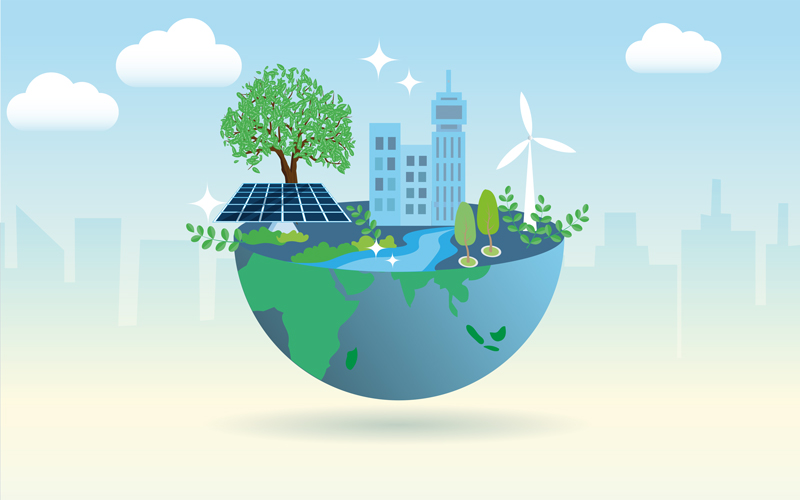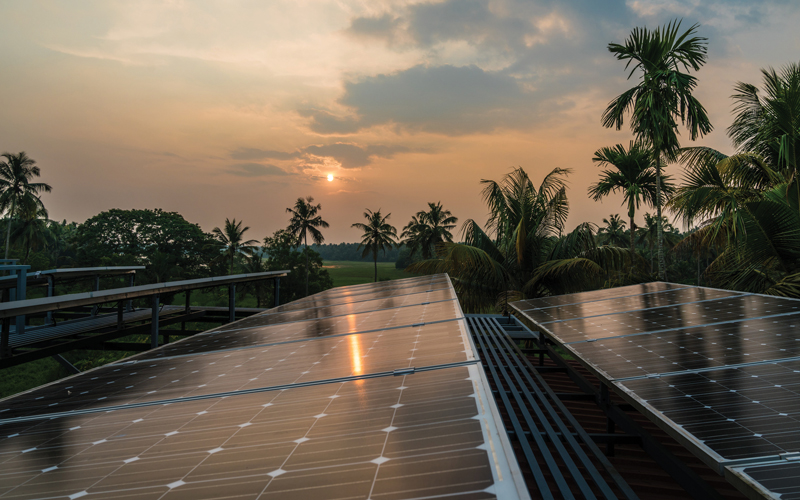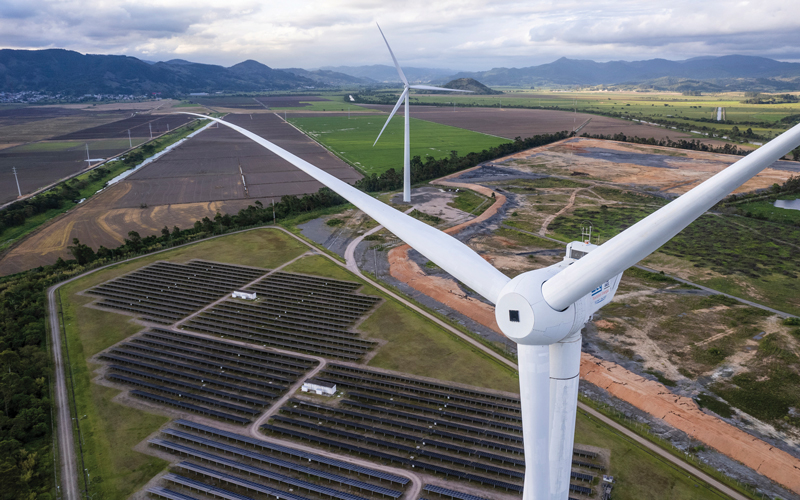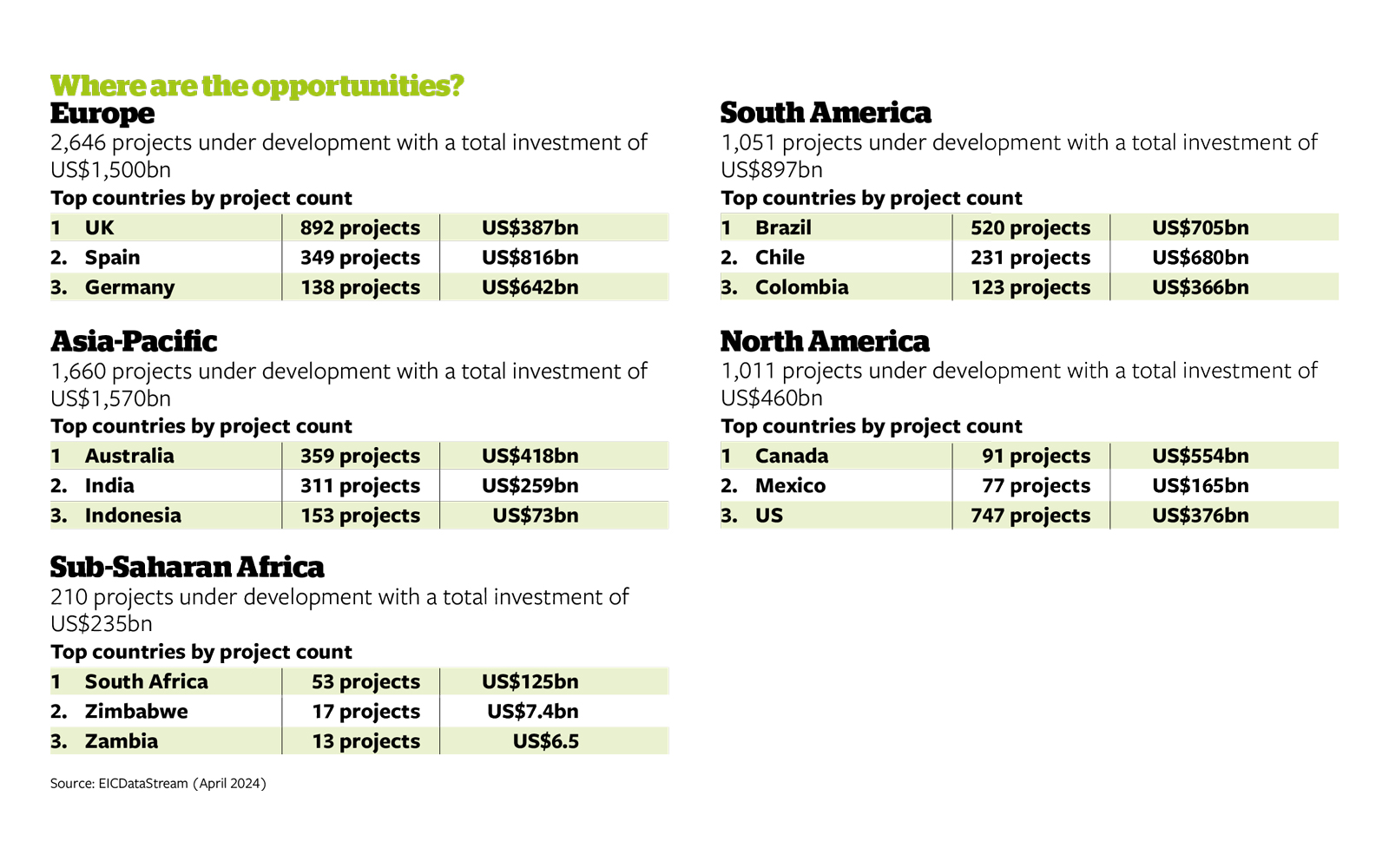Renewable energy prospects across Europe, Asia-Pacific, the Americas and Sub-Saharan Africa
Nabil Ahmed, Beatriz Corcino and Hazwani Izzati at EIC discover how geopolitical shifts, legislative changes and technological advancements are shaping renewable energy landscapes across Europe, Asia-Pacific, the Americas and Sub-Saharan Africa, driving unprecedented growth and transformation

Europe
Following the Russian invasion of Ukraine in February 2022, there has been a major geopolitical shift within Europe. The urgency of reducing dependence on Russian gas and enhance energy security has prompted a significant re-evaluation of the region’s energy sources. Consequently, the renewable energy sector has undergone profound growth and transformation to foster greater self-reliance among nations.
In November 2023, the amended Renewable Energy Directive came into effect. The EU’s legal framework, which looks to transpose its provisions into national law in 18 months, supports cooperation between EU countries towards a goal 42.5% of clean energy by 2030.
According to EICDataStream, there are more than 2,000 renewable projects in the pipeline to be completed by 2030, totalling 467GW and with a CAPEX of US$761bn. These predominantly focus on wind and solar energy. While some European nations have abundant renewable resources, others must rely on imports to meet their targets. As a result, countries are exploring diplomatic alliances and trade agreements to secure access to these crucial technologies.
Nordic leadership
The Nordic countries, including Norway, Sweden and Denmark, boast stable political environments and robust supply chains for renewable technologies such as wind turbines, solar panels and hydropower equipment. The region is home to key players such as Vestas and Vattenfall, which have been heavily involved in many offshore wind projects, especially in the UK, establishing cross-border trade between the markets.
Challenges facing UK wind
While the UK is hugely dependent on offshore wind capacity to meet its net-zero targets, inflationary pressures have led to delays and shelved projects. Speculation that there will be a new government following the upcoming general election suggests that there are changes ahead, particularly for sectors such as onshore wind, which continue to encounter political hurdles.
Sweden pushes solar, Germany dominates offshore wind
Sweden is expanding its solar ambitions and has recently unveiled a 1.2GW solar module plant in an effort to tackle its dependence on imports from China and South Asia. It is also expected to supply its solar modules to many European countries in the next decade. Meanwhile, Germany, known as an economic powerhouse, owes much of its strength to its extensive manufacturing and supply chain networks. This dominance is reflected in numerous offshore wind projects across the North Sea region, including the largest offshore wind farm to date – the 1.2GW Hornsea offshore wind farm.
Asia Pacific
Asia-Pacific (APAC) is undergoing a renewable energy shift, driven by environmental imperatives, technological advances and economic opportunities – with countries such as India, China and Australia leading the charge.
India’s solar focus
India is placing significant emphasis on solar energy, leveraging its abundant sunlight. With an existing solar generation capacity exceeding 80GW, it aims to increase this figure to 500GW by 2030. Foreign investments in solar power generation in India have surged, totalling nearly US$20.7bn between 2010 and 2019.
China’s offshore wind dominance
China leads in offshore wind capacity, achieving an installed capacity of more than 31GW by mid-2023 – the world’s largest operational offshore wind capacity.
Renewable momentum in Australia
In Australia, renewable energy sources, including solar, wind and hydro, accounted for 32% of total electricity generation in 2022, with the government pledging to increase this to 50%. The growing interest in green hydrogen is further driving the growth of the region’s renewable energy market.
Offshore wind boom in South Korea
EICDataStream is currently monitoring 66 offshore wind projects in South Korea, totalling more than 52GW. Major players include Korea Electric Power Corporation and Deep Wind Offshore, with foreign developers also entering the market. Notably, in November 2023, Corio Generation and bp proposed a US$1.092bn investment plan in South Korea’s offshore wind market. Other recent activities include bp’s partnership with Deep Wind Offshore for four projects with a potential capacity of up to 6GW, and Orsted’s plans to develop 1.6GW of offshore wind near Incheon.

Philippines’ offshore wind
Despite being a long-term prospect, the World Bank estimates that the Philippines has vast offshore wind potential of more than 178GW. Copenhagen Infrastructure New Markets Fund (CINMF) has signed contracts with the country’s Department of Energy for three offshore wind projects, totalling 2GW. Other key players include Vestas, AC Energy and PetroEnergy Resources Corp. BlueFloat Energy is also proposing four projects, totalling 7.5GW. A policy allowing 100% foreign ownership in renewable projects has been introduced to attract more investments – as shown by CINMF’s commitment. The Department of Energy has also granted numerous offshore wind energy service contracts.
Policy initiatives driving growth
Australia’s Offshore Electricity Infrastructure Act 2021 provides clear guidelines for operations and licensing. The government encourages investment in renewables through mechanisms such as reverse auctions. Contracts for Difference offer investors protection against price fluctuations, guaranteeing a fixed rate for generated output. Meanwhile, South Korea’s Green New Deal, launched in 2020, shows a significant commitment to renewable energy adoption. With a targeted investment of US$6.8bn by 2025, the stimulus package focuses on wind, solar and hydrogen projects, paving the way for sustainable energy development in the country.
The various policies and investment initiatives, plus an expanding pipeline of projects, reflect a growing commitment to renewable energy across APAC. This is evidenced by an expanding pipeline of projects and a concerted effort to transition to cleaner and more sustainable energy solutions.
Sub-Saharan Africa
Sub-Saharan Africa is in the early stages of its energy transition, with fossil fuels still playing a large role in the energy mix. Approximately 250 projects, totalling 140GW, are slated to come online by 2030, according to EICDataStream.
Progress has been slow, largely due to a lack of legislative frameworks and policies to drive ambitious renewable energy goals. Nonetheless, certain countries, including South Africa, Congo and Nigeria, are pushing for greater adoption of clean energy, with solar and hydroelectric power comprising a significant portion of their energy portfolios.
Due to limited local supply chain capabilities, the region relies on international suppliers, particularly from China and Europe – a trend expected to persist in the coming decade. Additional support is provided through initiatives such as the African Development Bank’s ‘Desert to Power’, which aims to enhance solar resources in the Sahel region, contributing to sustainable economic development across African nations.
The Americas
Building renewable energy capacity is central to transition strategies across the Americas, with EICDataStream tracking more than 785GW of projects set to commence operations by 2030. Offshore wind is an emerging segment in the US, Brazil and Colombia. The US has a considerable pipeline of fixed-bottom and floating developments, Colombia is holding its first auction for offshore wind areas and Brazil has more than 90 projects under environmental licensing. Beyond offshore wind, solar PV and onshore wind developments account for most renewable energy projects – EICDataStream is tracking 1,648 projects, with a total potential CAPEX of US$447bn.

North American political influence
Politics will shape energy trends in North America this year. There is speculation over the impact of a Trump administration on US clean energy development. One question is whether the Inflation Reduction Act will be discontinued. It is improbable that established renewable technologies such as wind and solar will be affected, especially in Republican strongholds. Investments in job-generating sectors such as manufacturing facilities for clean energy equipment are also likely to remain unaffected.
In Mexico, Lopez Obrador’s focus on oil and gas has deterred private investment in clean energy for five years. Claudia Sheinbaum, frontrunner in this year’s presidential election, is expected to adopt a more pragmatic approach, which could boost clean energy.
Renewable growth in South America
The outlook in South America appears promising, particularly in Brazil, Chile and Colombia. Brazil has allocated substantial investments to renewable sources, with projects scheduled for startup until 2030 totalling up to US$139.6bn. Regulatory discussions in Congress are underway regarding offshore wind, hydrogen and carbon capture and storage (CCS) frameworks, and the first offshore wind auction could take place in 2024 or 2025. Petrobras has unveiled an ambitious investment plan for 2024 to 2028 that includes allocations for offshore wind, CCS and biofuels.
In Argentina, a financial crisis has made many wind and solar projects ‘unbankable’, hindering its renewable energy potential. Chile, by contrast, has more than 231 projects at various stages of development, with many linked to clean hydrogen facilities.

Major Projects To Watch
Iceland
Greenvolt
Value: US$180m
Startup: 2027
Stage: Feasibility
Status: Planning
Operator: Greenvolt Energies Renovaveis SA
Denmark
Thor
Value: US$2.4bn
Startup: 2027
Stage: EPC
Status: Contract awarded
Operator: Thor Wind Farm I/S
Mozambique:
Mphanda Nkuwa Hydro Power Plant
Value: US$5bn
Startup: 2031
Stage: Feasibility
Status: Planning
Operator: TotalEnergies
South Africa
Oya Energy solar farm
Value: US$150m
Startup: 2026
Stage: FEED
Status: Government/authority approved
Operator: Engie
South Korea:
Floating offshore wind farm Firefly (Bandibuli)
Value: US$2.5bn
Startup: 2028
Stage: FEED
Status: Contract awarded
Operator: Equinor
US
New England Solar Farm Phase II
Value: US$350m
Startup: 2025
Stage: FEED
Status: Government/authority approved
Operator: UPC Renewables
Coastal Virginia Offshore Wind
Value: US$9.8bn
Startup: 2026
Stage: EPC
Status: Contract awarded
Operator: Dominion Energy
Brazil:
Costa Branca 2 Offshore Wind Farm
Value: US$5.25bn
Startup: 2033
Stage: Feasibility
Status: Planning consent applied
Operator: Petrobras
Source: EICDataStream (April 2024)
Interested in exploring global renewables opportunities?
Inform your decision-making with the latest contracting activity and market research from EIC.
To discuss your needs, email Khairun Suffia Sulaiman at khairun.Suffia@the-eic.com
Image credit | iStock | Supplied






Follow us
Advertise
Free e-Newsletter